2018 Superbike comparison: Aprilia RSV4 RF Vs BMW S1000RR Vs Ducati Panigale V4 S
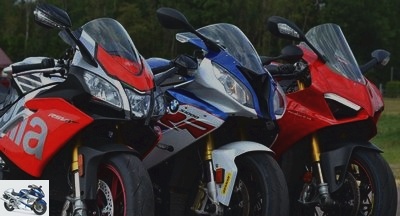
A year after having compared the four Japanese Superbikes, Site opposes three – super – European productions: the recent Aprilia RSV4 RF and BMW S1000RR (full options) compete against the all new Ducati Panigale V4 S… On the way to the circuit !
Comparo SBK 2018 – page 2: On the road, the BMW takes the lead
First observation by taking into hands gloves the three motorcycles of this new Superbike comparison: the BMW is indeed the least light of the strip. However, the difference of 13 kg between the S1000RR and the Panigale V4 S according to the manufacturers’ data sheets (see page 4) seems exaggerated….
The weights which appear on the gray cards of "our" test vehicles seem more likely: 200 kg for the Ducati (against 195 announced) and 208 kg (still) for the BMW. Right in between, the Aprilia is maneuvered without any difficulty … These sports cars just sin by their large turning radius. Nothing surprising so far.
The radical position of the Aprilia does not surprise either: wrists resting, buttocks resting on a hard saddle and tilted forward, culminating at 845 mm … The little pilots struggle to put both boots on each side! On the contrary, adults welcome this height because their legs are less bent than on competing motorcycles. Who would’ve believed that ?
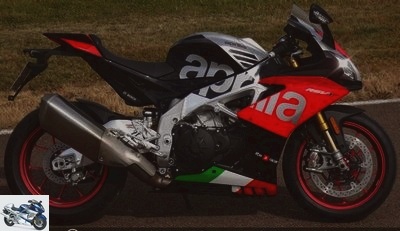
Thanks to its ultra-compact V4 and well-flared fuel tank, the RSV4 offers excellent grip on the thighs. This is not the case with the BMW whose 4-in-line widely spreads its legs. The S1000RR makes up for it with the lowest saddle and slightly padded, a lower handlebar … For a little, we would qualify it as a sporty road! Like the old GSX-Rs.
Finally, the Panigale V4 offers the most demanding ergonomics: hard and relatively high saddle associated, high and remote footrests. She bends her legs copiously! As on the Aprilia, the V4 – a little bigger – gives the Ducati a "Vespa" size. The thighs run alongside a perfectly flat fairing: well seen for once !
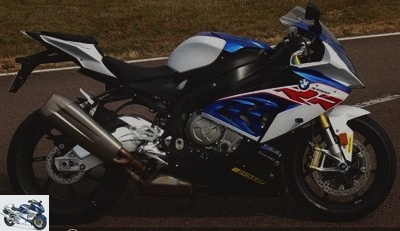
The half-handlebars of the Rouge de Bologne are located a little further forward, and above all spread the driver’s hands more apart: 50 cm on the Ducati, 47 on the Aprilia, 46 on the BMW. Read like that, it may not seem like much. But handle in hand, the difference is noticeable! At MNC, we therefore prefer the BMW. But this is just the beginning of this comparison…
By starting the engines, the Ducati clearly takes the ascendancy, in terms of decibels! The Desmosedici Stradale has, by far, the most buzzing, the most disturbing sound … and the most swelling too, because it is impossible to go unnoticed in its company. With one exception.
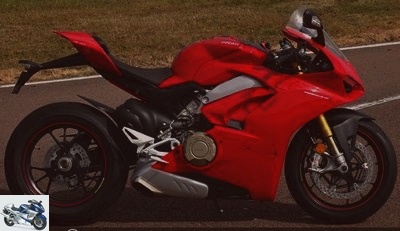
Indeed, the Bologna V4 mutes in very specific conditions: when parade – in town – on 3rd gear, between 49 and 54 km / h meter! Then and only then, the sound level of the new Panigale proves to be exceptionally acceptable..
The "Twin Pulse" crankshaft setting at 70 ° (as on the Grand Prix prototype) gives the Ducati V4 opened at 90 ° a more jerky melody than that of the Aprilia V4 open at 65 ° (and stalled at 180 °). Mechanical noise is also more present on the Panigale: bordering on disturbing, beware !
Less noisy at idle, the Aprilia growls almost as loud as its compatriot when the right handle is rotated. Particularly pleasant and intoxicating, the sound of the RSV4 is not too tiring: with it, earplugs are not mandatory.
When we come to town…
Beside the two Italian talkers, the German seems oddly discreet! The 4-in-line gives off an impression of quiet strength: its regular purring in slow motion can turn into a hoarse growl, but only in the second half of the tachometer … Like a Japanese, self-effacing but always ready to attack !
At the very beginning of our ride, however, the S1000RR plays the transalpine divas: impossible to select a partial trip to reset it before leaving! Is the on-board computer stranded? From the first intersection, flashing light failure. MNC notices that the entire left stalk no longer responds…
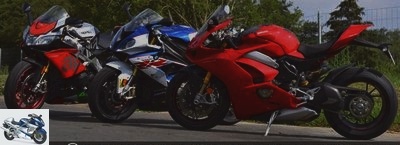
Quick return to BMW France, where the mechanic is surprised to see us again, just five minutes after giving us his machine! Short manipulation of the electrical connection and everything is in order: the horn works, as well as all the other controls.
"It also surprised me," the fairy-fingered mechanic tells us, "I checked it last night and everything was working perfectly. It must be because of the clean-up this morning with the karcher," concludes- he placidly … Note for later: take it easy on the pressure of the water jet at the next motorcycle cleaning !
It is therefore aboard a fully functional BMW that MNC restarts this Superbike comparison. The 4-in-line is pleasantly smooth and super round: idling in any gear is no problem for it, and the pickups are done without the slightest jerk.
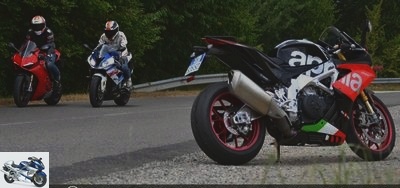
On the Italians, the mechanics are less accommodating. It is necessary to maintain the "small" V4 of Aprilia beyond 2500 rev / min not to upset it. It is however possible to trot in small villages "in" 4th gear, at 50 km / h.
The "big" Ducati V4 requires dropping 3rd and requires 500 more laps. It must also be set in "Street" mode (the softest) so as not to knock too much. In the two more sporty modes, the Panigale tends to overreact to small rotations of the right wrist..
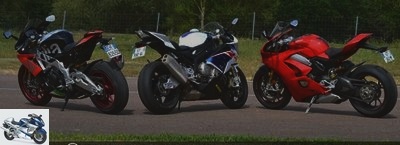
In addition, due to its particularly long 1st gear – compared to the BMW especially – and a very dry clutch point of attachment, the Ducati requires skill to make it spin and not stall in the fire, in the center – town, in front of the terrace of a crowded cafe. Shame !
On the road – two-way without a central splitter – the RSV4 trots at 80 km / h just below 3250 rpm in sixth. Under the same conditions, the tachometer of the BMW indicates 3250 rpm, that of the Panigale V4, 3500. On the peripheral therefore (70 km / h), the Ducati struggles to stay on the last report…
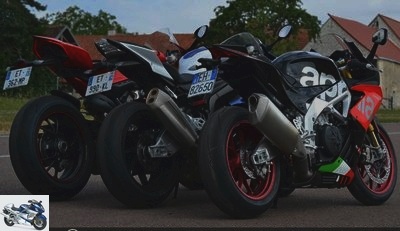
Rougher, less docile, the Ducati engine is on the other hand associated with the best quickshifter of the bunch: once the Panigale is launched, up and down gears is a real child’s play! With each downshift, the "Desmo" climbs quickly and noisily in the towers: a good point on the road and on the circuit…
The BMW "shift assistant pro" would be at the level of the Ducati if its feel were better: the feeling of locking gears is not as clear as on the Panigale. The gas shots automatically given by the S1000RR to downshift are less sharp than on the Panigale V4: a good point in town! We also appreciate not using the left lever too much, which is hard in the long run..
Light the fire !
The "quick shift and down shift" of the Aprilia is less fast and less smooth than its rivals, especially when cold. It is also inoperative under 3000 rpm: too bad for bikers who use their sports car on a daily basis (raise your hand to see? Ah anyway!).
During the first kilometers, covered in heavy and slow traffic, the Journal Moto du Net noticed that the S1000RR scored other points. First of all, it seems more agile between 30 and 50 km / h. Is it because of its lower frame angle or a less rigid steering damper? Or a bit of both ?
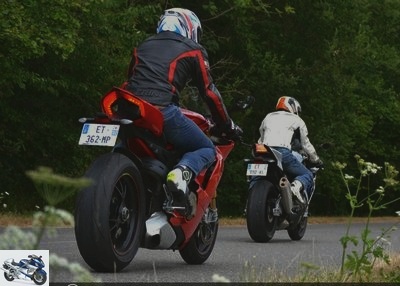
What is certain for Site is that the driver’s posture on the BMW greatly facilitates its handling: the back is straight and slightly arched, the weight of the bust does not rest too much on the wrists, the arms are therefore more free to their movement … The front axle seems lighter, CQFD.
Scratched from the specifications of sports motorcycles for several years now, the practical aspects once again make the S1000RR shine: the Bavarian is the only one able to carry a disc lock or a yellow vest (compulsory in France!) Under the passenger seat..
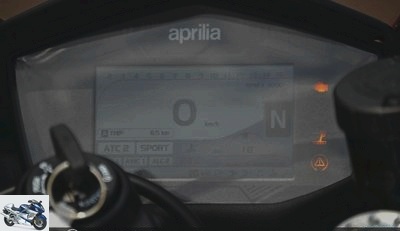
On the RSV4, we regret the absence of a warning allowing to be better distinguished in the flow – uninterrupted! – cars and trucks stopped on the Paris ring road. In the absence of a visual warning device, you can always place a few short bursts of gas to stand out in traffic…
For its part, the Panigale V4 has two big shortcomings on a daily basis. Significant vibrations in the mirrors prevent you from detecting whether a Tmax or a R1200RT goes all the way up towards you, or whether a PCX or a 125 Duke is approaching quietly. Second complaint: the horrifying side stand, impossible to deploy with a track boot !
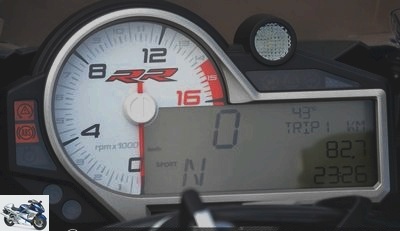
Another inconvenience shared by our three horses this time: the heat that emanates from their water mills, which is difficult to bear in town when the outside temperature is around 25 °. The Ducati is particularly grueling with its twisted rear manifold which grates the upper legs and buttocks.
But the Aprilia is no more accommodating: it requires long legs to get high in the saddle when stationary, in order to momentarily step away from the boiling engine and frame. The BMW, for its part, requires good flexibility at the level of the hips to lift its thighs from the tank and circulate a little air … Go hop, direction the highway !
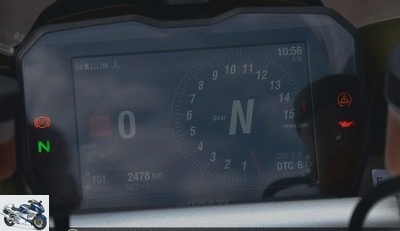
The A4 which should lead us quickly to the Circuit des Écuyers in Beuvardes (02) is initially limited to 90 km / h … At the head of the procession, the pilot of the docile S1000RR stalls at "95 meter" thanks to the regulator, imitated by the colleague on the Aprilia (no "Cruise control" on the Ducati). But peace is short-lived on the BMW.
From 4000 rpm in fact, or just under 100 km / h in 6th gear, the German 4-legged swings unpleasant crackling in the handlebars. Rare bikers will see it as an excellent "tactile" marker avoiding driving too fast on an open road … The majority will rail against this weak point which penalizes a BMW hitherto very civilized.
I love you, neither do I
Higher in the towers, the vibrations of the S1000RR reach the feet and buttocks. These sensitive areas are however spared when the maximum speeds are respected on expressways. On the Aprilia, vibrations appear in the levers when we can – finally – gallop at 140 km / h, but they are bearable by placing the fingers around the handlebars which tremble much less than that of the BMW.
The Ducati for its part, is very gentle on the hands and buttocks. Pulsations are detected at the level of the footrests but are not disabling. Much less in any case than the boom of the pot, the hardness of the saddle, the pressure on the wrists, or partial protection…
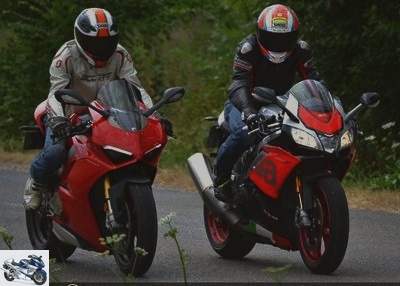
The Ducatist’s bust is correctly deflected by the high bubble of the Panigale V4, and his head can be isolated from the turbulence by lying on the large tank. The arms on the other hand never have a break! The lower but wider bubbles of the RSV4 and S1000RR protect better on the side, less upwards ….
Coming off the highway, MNC heads for a gas station to refuel. The Ducati has been on the reserve for a few kilometers: paradoxically, the largest and most powerful engine has the smallest tank! Only 16 liters to water 214 horses.
Over all of our driving on the road, at legal speeds (yes, yes!) The Panigale V4 S was the most voracious: 6.6 l / 100km on average, i.e. a range of just over 240 km . In contrast, the S1000RR is capable of covering 300 km in one go thanks to its reasonable consumption (5.8 l / 100km) and its 17.5 liters of capacity..
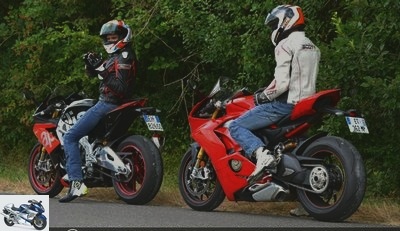
A little less greedy than its compatriot (6.3l / 100km), the RSV4 RF takes advantage of its large tank (18.5 liters, the largest in the comparison) to knock down almost as many terminals as the German: about 290 km, despite consumption half a liter higher.
MNC regains the circuit by small roads, on which the BMW naturally takes the lead … in the literal sense of the word, more in the figurative sense! Installed more flat on his bike and taking advantage of the suspensions that provide a bit of comfort in intermediate mode (Sport), the Behemist traces faster than the friend perched on the Aprilia previously adjusted ass fuck for the track.
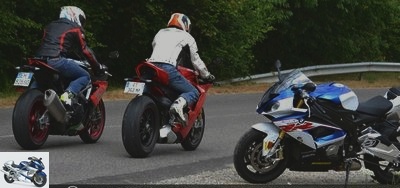
By selecting Rain mode, the S1000RR rider benefits from even better damping, but has to deal with seriously controlled acceleration in low and mid revs, comparable to that of an 800 cc roadster. Be careful, however: by insisting on the accelerator, the 4-legged regains force. !
Although shaken by his original Swedish suspensions, the driver of the RSV4 RF controls his machine remarkably well by tightly gripping the tank: incisively, the Aprilia melts from one turn to another with a simple blow of the hip! No need to play big arms.
The Ducati, on the contrary, requires good pairs of biceps and triceps: the wide handlebars twitch at the slightest imperfection on the road! At the rear, the shock absorber works relatively well, provided you engage the Street driving mode, more comfortable than the Sport mode … or the Race mode reserved for the track. We get there, precisely.
Related articles
-
2018 Superbike comparison: Aprilia RSV4 RF Vs BMW S1000RR Vs Ducati Panigale V4 S A year after having compared the four Japanese Superbikes, Site opposes…
-
2018 Superbike comparison: Aprilia RSV4 RF Vs BMW S1000RR Vs Ducati Panigale V4 S A year after having compared the four Japanese Superbikes, Site opposes…
-
2018 Superbike comparison: Aprilia RSV4 RF Vs BMW S1000RR Vs Ducati Panigale V4 S A year after having compared the four Japanese Superbikes, Site opposes…
-
2018 Superbike comparison: Aprilia RSV4 RF Vs BMW S1000RR Vs Ducati Panigale V4 S A year after having compared the four Japanese Superbikes, Site opposes…
-
Comparison test of V4 superbikes Ducati Panigale V4 S Aprilia RSV4 RF
Ducati Panigale V4 S and Aprilia RSV4 RF V4 superbikes in comparison test Content of Like an invasion, the brand new Ducati Panigale storms into the V4…
-
Comparison test Aprilia RSV4 R APRC and Ducati 1199 Panigale
Comparison test: Aprilia RSV4 R APRC and Ducati 1199 Panigale Tea best Italian superbikes in comparison The more expensive versions first – few sales and…
-
Panigale V4, RSV4 and S1000RR comparison: on-board camera on the circuit While waiting for our complete comparative test, the Motorcycle Journal of the…
-
RSV4 1100 Factory test: high volume operation at Aprilia ! The Italian 4-cylinder V feel decidedly cramped in a single liter: the RSV4 1100 Factory…
-
959 Panigale test: Site takes on the 2018 Ducati Challenge Which motorcycle to choose to start competing? Le Journal moto du Net had never asked the…
-
Italo athletes in comparison: Aprilia RSV4 Factory, Ducati Panigale S and MV Agusta F4 R.
Aprilia RSV4 Factory, Ducati Panigale S and MV Agusta F4 R in the test The three tenors Your stage is the race track. And a joint appearance by Aprilia…